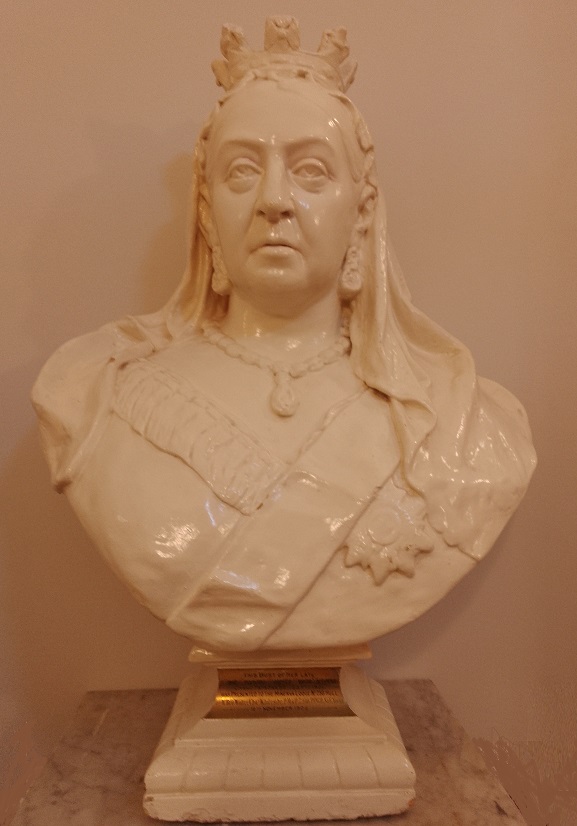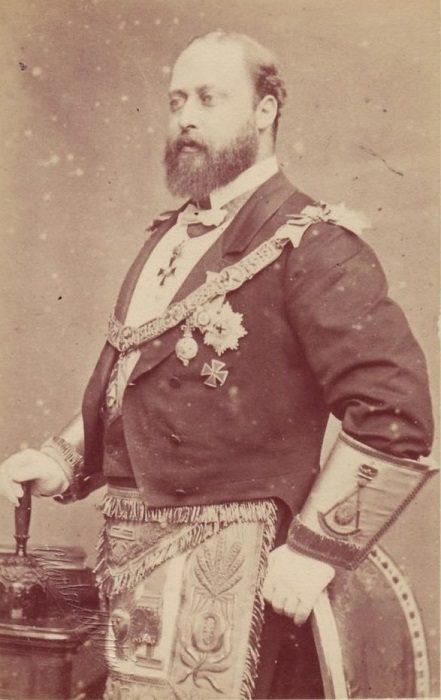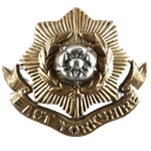The Twentieth Century
The next decade was one of prosperity for the Minerva Lodge. The initiation fees were raised from ten guineas to twelve guineas; the joining fee was half that amount. The bust of W Bro J P Bell MD, PM, PGDEng., PDPGM N&E Yorks (see page 5) was presented by Bro R Toogood on behalf of Br W D Keyworth. The membership in July was 169 members. At this time HRH the Duke of Connaught KG &c., &c. was installed as Most Worshipful Grand Master of English Freemasons
 Queen Victoria died in January 1901 and Lodges were ordered to be in mourning for six months. A bust of the late queen was presented to the Lodge in 1902, with a brass plate:
Queen Victoria died in January 1901 and Lodges were ordered to be in mourning for six months. A bust of the late queen was presented to the Lodge in 1902, with a brass plate:
*
THIS BUST OF HER LATE
Most Glorious Majesty Queen Victoria
GRAND PATRONESS 1837 TO 1901
WAS PRESENTED TO THE MINERVA LODGE NUMBER 250, HULL
by W Bro Walter Chas Whiteside, PM & PZ 250, PPGD North & East Yorks
- 12th November 1902 -
*
The bust stands by the Dagger Lane entrance, looking sternly at all who enter.
 She was succeeded by her son Edward VII, (Bertie) who was then fifty-nine. Edward, Prince of Wales before becoming King, was Grand Master of the United Grand Lodge of England from 1874 but stood down to become IPM when he became monarch. Radical changes were already at work during this period, and the social reforms of the Liberal government of 1906 - 1914 laid the foundations of what would become to be known as the Welfare State. The middle class was expanding. W Bro W C Whiteside presented to the Lodge a bust of Her late Majesty Queen Victoria in November 1902.
She was succeeded by her son Edward VII, (Bertie) who was then fifty-nine. Edward, Prince of Wales before becoming King, was Grand Master of the United Grand Lodge of England from 1874 but stood down to become IPM when he became monarch. Radical changes were already at work during this period, and the social reforms of the Liberal government of 1906 - 1914 laid the foundations of what would become to be known as the Welfare State. The middle class was expanding. W Bro W C Whiteside presented to the Lodge a bust of Her late Majesty Queen Victoria in November 1902.
In the meantime, Masonry in Hull and elsewhere continued to flourish. The Hull Golf Club was formed in 1904 and seven of its nine founder members were also members of Minerva Lodge. Bro Haggitt Colbeck was the first Captain. The Golf Club was sited on Anlaby Road where the old Hull City Football Club played at Boothferry Park. Also in 1904 Hull established its own independent telephone system - with its distinctive cream coloured kiosks, and the Hull City Association Football Club was formed.
Haggitt Colbeck was WM of the Minerva Lodge in 1897. His brother, Captain Wm Colbeck, RNR, FRGS, Commander of the National Antarctic Relief Ship, steam yacht "Morning" was sent a cablegram from the Lodge, congratulating him for conveying relief to Scott's ship "Discovery" stuck in the ice at McMurdo's Sound in 1903, and a year later, after other Antarctic adventures, Captain Colbeck delivered a lecture to the Lodge about his experiences, illustrated by lantern slides. Another member of Captain Scott's expedition was Ernest Shackleton. Both were freemasons.
It was in November 1905 that the Lodge Treasurer was able to hand to the WM the deeds of the premises "free of all encumbrances." Unfortunately, they became lost some time afterwards.
In the Edwardian decade fashionable men generally wore three-piece suits, with high, round-collared white shirts, neckties and derby or bowler hats. In summertime slightly more casual linen or flannel duits were worn with a straw boater or Panama hat. Sports gear specific to to the activity (golf, tennis, motorcycling) was worn.
Humber Lodge 57 were having extensive alterations to renovate its building in 1910, and was granted permission to use the Dagger Lane premises; the Humber Mark also took up temporary residence.
 Edward VII died in 1910 and was succeeded by George V. The Great War began in 1914. Its effects were far reaching, and war-related charitable causes were well supported by Freemasons and eventually led to the formation of a major new Masonic charity in the post-war period. Minerva Lodge brethren demonstrated their patriotism and generosity with donations, including contributing to the cost of a motor ambulance, to interned brethren in Germany. to the YMCA, and children of soldiers and sailors blinded in the war.
Edward VII died in 1910 and was succeeded by George V. The Great War began in 1914. Its effects were far reaching, and war-related charitable causes were well supported by Freemasons and eventually led to the formation of a major new Masonic charity in the post-war period. Minerva Lodge brethren demonstrated their patriotism and generosity with donations, including contributing to the cost of a motor ambulance, to interned brethren in Germany. to the YMCA, and children of soldiers and sailors blinded in the war.
It was a difficult time for everyone, and Masonic meetings were certainly affected. The reports supplied by Masonic Secretaries tended towards brevity but frequent mention was made of donations from the Benevolent Funds.
Over an estimated 70,000 people from Hull served in the forces. The Hull Pals lost 2,000 men and over 7,000 local men and women were killed, with double that number wounded or disabled. On average Hull received fifteen casualties every day of the war, nearly 70% aged under thirty, including 1.500 teenagers.
The first Zeppelin attack on Hull was in June 1915, shortly before midnight. One bomb landed on the old High Street, making  a deep hole and fracturing thee gas and water mains. The gas main was ignited by the blast, but was extinguished with wet clay. Some of the bombs dropped caused Edwin Davies' Drapery shop (he was a freemason and a member of Kingston 1010) in the Market Place to burn to the ground. The heat was so intense that the lead of Holy Trinity's stained glass windows melted. The wind blew from the north west, away from the church which saved it from destruction.
a deep hole and fracturing thee gas and water mains. The gas main was ignited by the blast, but was extinguished with wet clay. Some of the bombs dropped caused Edwin Davies' Drapery shop (he was a freemason and a member of Kingston 1010) in the Market Place to burn to the ground. The heat was so intense that the lead of Holy Trinity's stained glass windows melted. The wind blew from the north west, away from the church which saved it from destruction.
 Hull people were still largely unprepared for attacks from the sky, and the damage augmented anti-German feeling. The German community in Hull at that time was about 1.000 and many fled due to mob attacks on their homes and shops. One butcher (Hohenrein & Sons) had become a naturalised Englishman and his son was born in Hull: he changed the name to Ross in 1915 and put an announcement in the paper.
Hull people were still largely unprepared for attacks from the sky, and the damage augmented anti-German feeling. The German community in Hull at that time was about 1.000 and many fled due to mob attacks on their homes and shops. One butcher (Hohenrein & Sons) had become a naturalised Englishman and his son was born in Hull: he changed the name to Ross in 1915 and put an announcement in the paper.
I am grateful to Neil Armstrong, who sent me information regarding Masonic losses, gathered from Provincial records and from UGLE's Roll of Honour. This is of those in the services who actively fought, and makes no mention of the many other war casualties who were masons, and we honour them all.
 Of the local Lodges, De la Pole 1605 lost two Brethren, Kingston 1010 four. It is perhaps unsurprising that Brethren from nearby Lodges were killed together; Humber Lodge 57 and Minerva were very close and friendships established. From the former, Bro James Short, 1st Engineer on the Tycho, was killed off Beachy Head along with Bro George Williams, a marine and member of Minerva. The Tycho was torpedoed and fifteen crew were lost; another vessel that came to help was also sunk. Thirty-seven-year-old Chief Engineer Walter Ramsey, "lost at sea 1916" was from Humber Lodge, as was Captain Charles Cook Smith. Not all losses were at sea: on record is the death of Lieutenant Cyril Gough, Infantryman of the East Yorkshire Regiment, killed in the final advance in Flanders on 11th October 1918. He had been initiated into Minerva Lodge in February 1902.
Of the local Lodges, De la Pole 1605 lost two Brethren, Kingston 1010 four. It is perhaps unsurprising that Brethren from nearby Lodges were killed together; Humber Lodge 57 and Minerva were very close and friendships established. From the former, Bro James Short, 1st Engineer on the Tycho, was killed off Beachy Head along with Bro George Williams, a marine and member of Minerva. The Tycho was torpedoed and fifteen crew were lost; another vessel that came to help was also sunk. Thirty-seven-year-old Chief Engineer Walter Ramsey, "lost at sea 1916" was from Humber Lodge, as was Captain Charles Cook Smith. Not all losses were at sea: on record is the death of Lieutenant Cyril Gough, Infantryman of the East Yorkshire Regiment, killed in the final advance in Flanders on 11th October 1918. He had been initiated into Minerva Lodge in February 1902.
 After the war, Hull began to build new housing estates and major urban developments changed the face of the city. Craven Park was inaugerated in 1922. Sutton became part of Hull in 1927, the year the University was founded, (though it was originally known as University College Hull, with thirty-nine students and fouteen "one-person" departments.) The foundation stone was laid the following year by the Duke of York (later George VI.) Albert Frederick Arthur George was initiated into the Navy Lodge 2612 in 1919 and was installed as Wm in 1921. He was Senior Grand Warden of UGLE in 1923 and Provincial Grand Master of Middlesex in 1924. He was appointed a Past Grand Master of England in 1937.
After the war, Hull began to build new housing estates and major urban developments changed the face of the city. Craven Park was inaugerated in 1922. Sutton became part of Hull in 1927, the year the University was founded, (though it was originally known as University College Hull, with thirty-nine students and fouteen "one-person" departments.) The foundation stone was laid the following year by the Duke of York (later George VI.) Albert Frederick Arthur George was initiated into the Navy Lodge 2612 in 1919 and was installed as Wm in 1921. He was Senior Grand Warden of UGLE in 1923 and Provincial Grand Master of Middlesex in 1924. He was appointed a Past Grand Master of England in 1937.
The Minerva Lodge post-war minutes show the involvement of the Lodge in necessary charity contributions both nationally and locally (e.g. in February 1919 the sum of 100 guineas was granted from the Benevolent Fund to the Royal Masonic Benevolent Institution (Chairmanship Festival) and in January 28th 1920 the sum of £63/14s was collected for the local Fund for the Support of the Children of Soldiers and Sailors blinded in the War.) But social events begin to appear: in March 1920 a Whist Drive was held by the WM (W Bro T Goldie) and his Officers, and the following year WM G H Jefferson held a Dance.
The by-laws of the Lodge were revised by the Committee in 1920 and approved and adopted the following year. 1923 saw the retirement of the PGM, R W Bro the Most Hon The Marquess of Zetland, and the installation of his successor, the Most Hon Lawrence John Lumley, the Rt Hon the Earl of Ronaldshay as Right Worshipful Grand Master N & E Province of Yorkshire.
In 1924, 1925 and 1926 Receptions were held at the Lodge, by the WMs and their Officers. The Lodge returns to Provincial and UGLE on June 24th 1929 show a membership of 230. 1925 saw the consecration of Minerva's third daughter Lodge, the Lodge of St Andrew 4683.

